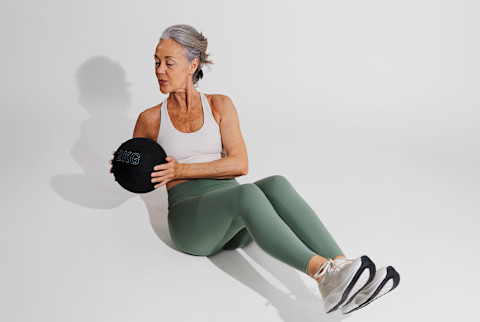New Study Shows Training (With Heavy Weights) Is Key To Preserving Muscle With Age

Aging definitely comes with some pros (having more time to focus on yourself postretirement) and cons (decreasing muscle mass). In fact, you lose about 3-8% of your muscle each decade after 30—and the rate increases after you turn 60.
If muscle health or exercise is something that has taken the back burner to long workdays or caregiving responsibilities, then retirement is a great time to pick up the heavy weights.
Researchers of a new study looked at the impact of different types of strength training on muscle strength and function in adults ages 64 to 75. And they found one type of training to be the most effective at building and preserving muscle years later. Here's what you need to know.
Strength training is a way to combat age-related muscle changes
This study was one of the first to look at the long-term benefits of strength training in older age.
There's no doubt that building muscle as you get older gets harder. Muscle protein synthesis (the process of building and repairing muscle) becomes less efficient, hormones that stimulate muscle growth (like testosterone and growth hormone) decline with age, and increasing inflammation can damage muscle cells.
Heaps of older studies continuously show that strength training regimens prevent muscle loss, build lean mass, and enhance strength. However, these studies only look at the impact of exercise during the actual trial and maybe the impacts six months to a year after the study ends.
For this study, researchers were specifically interested in whether heavy lifting is required to see lasting muscle gains in older adults, say two, three, and even four years later. Sure enough, there are benefits to training heavily.
Heavy vs. moderate lifting has longer-term benefits
In total, 451 adults living in Denmark were randomized into one of three groups—heavy resistance training, moderate-intensity training, and a control group (those who just maintained their habitual physical activity)—for a year of supervised training.
Heavy-lifting schedule:
- Used machines (not free weights) for exercises 3 times a week
- Did 9 total exercises
- Completed 3 sets of 6-12 repetitions at 70%-80% of their max strength
Moderate-intensity schedule:
- Circuit training of bodyweight and resistance band exercises 3 times a week
- Did 9 exercises that mimicked the machine exercises
- Completed 3 sets of 10-18 repetitions at 50%-60% of their max strength
Control group:
- Maintained their typical activity levels
- All participants in this study were pretty active to begin with, averaging nearly 10,000 steps daily
Results showed:
- Both weight training groups saw significant improvements in muscle strength and function—improvements were more pronounced in the heavy lifting group.
- Those in the heavy training group maintained their total lean mass and strength fou years later.
- Strength declined after four years in the control group.
- There was a slight decrease in strength in the moderate-intensity group, but it wasn't significant.
What does this mean for you?
Have hesitation about picking up the weights?
Hearing the words heavy weights in your 60s or 70s (or any age, really) can feel intimidating if you haven't done these workouts before.
But heavy means something different to everyone. The goal should be choosing something that takes you 70-80% of the maximum weight you can lift—that could be a 5-pound weight for a bicep curl or a 15-pound weight, depending on where you're starting.
If you don't know where to start, working with a personal trainer may be extremely helpful in setting up a program that's tailored to you and your goals. These sessions can also help build your confidence using machines or free weights at the gym.
We also pulled together this comprehensive list of exercises you can do with weights at home that target all the major muscle groups.
Additional ways to support your muscles
Strength training is absolutely one of the best ways to keep your muscles strong, healthy, and functioning. But you also need to make sure you're eating enough protein.
Dietary protein is needed to support optimal muscle growth from exercise and a speedy recovery. So, how much protein do you need? A good goal is to aim for 1 gram of protein per pound of body weight a day. So, if you weigh 140 pounds, try to eat about 140 grams of protein between all your meals and snacks. (Here's a high-protein meal plan for inspo.)
Another nutrition adjustment to help enhance muscle mass in middle age and beyond is creatine. Creatine is known as a sports supplement, but it actually helps everyone participating in a strength training program get stronger and build more muscle than just exercise alone.*
It's the ultimate longevity supplement (and mindbodygreen's creatine with taurine+ combines 5 grams of creatine with 2 grams of taurine for even more longevity and cardiovascular perks).*
The takeaway
Preserving muscle as you age should be a top priority. How much muscle (and bone mass) you have is closely tied to longevity, and strength training with heavy weights is one of the only ways to prevent muscle loss with age, and it's the only way you can continue to build muscle.

